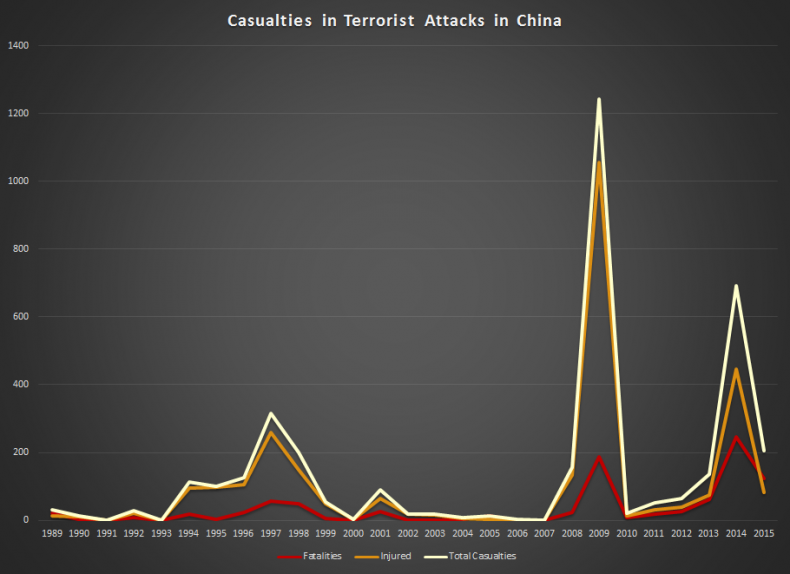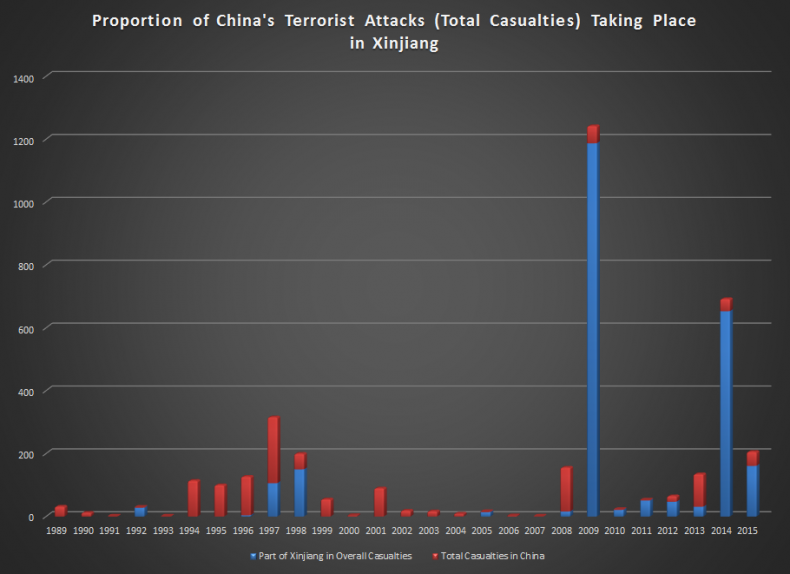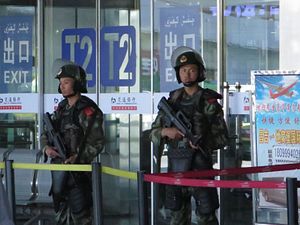Though it’s far from the headlines of most Western newspapers and magazines, terrorism remains an issue in China, and in the northwestern province of Xinjiang in particular. The 9/11 attacks brought Islamic terrorism under the spotlight, and by doing so, provided the Communist Part of China (CPC) with new rhetoric to apply to its security policy in Xinjiang, articulated around George W. Bush’s “War on Terror.” Since then, Uyghur activists have been systematically labelled as terrorists by the Chinese authorities. As Chien-peng Chung explains: “the government considers these activists part of a network of international Islamic terror, with funding from the Middle East, training in Pakistan, and combat experience in Chechnya and Afghanistan.”
The Domestic Security Response in Xinjiang
The Chinese regime implemented a comprehensive panel of security measures in Xinjiang, built on the twin assumptions that Islamic terrorism was the most prominent security threat to the Middle Kingdom and that its roots were to be found in the Uyghur ethnic minority. Those security measures include the intervention of the People’s Liberation Army (PLA) and various paramilitary organizations such as the People’s Armed Police (PAP) and the Xinjiang Production and Construction Corps (XPCC). It is important to note that the PLA remains an institution controlled by Han Chinese and that although Uyghurs can enroll, there are in fact very few of them in senior military posts. As for the PAP, the Chinese government stresses that one of its most prominent roles is to “hunt down the East Turkestan terrorists.” The number of guards on duty everyday nationwide within the PAP is now up to 260,000.
The XPCC is a unique outfit. Stephan Blank defines the XPCC, created in 1954 by Mao Zedong to enhance stability in Xinjiang, as a “quasi-military/business conglomerate” which employs about 2.4 million people (probably more than 2.6 million today, out of the 22.6 million overall population of Xinjiang), almost all Han Chinese. The XPCC owns about one-third of the land in Xinjiang, with an industrial production of approximately 25 percent of Xinjiang’s total output. In the light of the emphasis put by the Chinese regime on anti-terrorism over the past decade, the XPCC is to play a prominent role in ensuring the security of the region. Chinese President Xi Jinping stated that he wanted “walls made of copper and steel” and “nets spread from the earth to the sky” to defend against terrorism in Xinjiang, while also advocating the central role played by the XPCC in Xinjiang’s development.
The use of military and paramilitary forces to crack down on Xinjiang has also been complemented by domestic soft policies such as the “Go West” migration policies, which encourage Han Chinese to settle in Xinjiang. An influx of Han is used to counterbalance the presence of Uyghurs and provide demographic prevalence to the Chinese majority ethnic group.
The CPC’s crackdown on Xinjiang did not start immediately after 9/11, but it is undeniable that the worldwide crystallization of security concerns around Islamic terrorism provided a solid ground for the Chinese regime to implement very harsh security measures in a region which had recurrent separatist issues throughout modern Chinese history. The ties discovered between the East Turkestan Islamic Movement (ETIM) and al-Qaeda in 1999 were legitimate concerns for China, but the security measures implemented by the CPC as a response to the terrorist threat in Xinjiang still seem excessive. Colin Mackerras explains in his book China, Xinjiang, and Central Asia: History, Transition and Crossborder Interaction into the 21st Century that the “strike hard” campaigns led by the CPC to ensure security in China were essentially directed toward Uyghurs in Xinjiang and aimed at targeting their religious activities, including religious education, allegedly to prevent the propagation of Islam. Some of the most noticeable policies include, for instance, banning Muslim children from religious institutions, the obligation for Uyghurs to sell and advertise alcohol in their shops, and the passport confiscations in Xinjiang.
Evaluation of the Chinese Counterterrorism Policy
The question that arises now is whether or not those new policies were effective in reducing the terrorist threat in Xinjiang. An overview of the data available indicates that the new Chinese counterterrorism policy implemented after 9/11 and based on the concept of “War on Terror” has been mostly inefficient in reducing the terrorist threat in China overall. A look at the data shows that casualties from terrorist attacks in China are in fact on the rise.

The evolution of casualties in terrorist attacks in China over time (Source: Global Terrorism Database)
More importantly, Xinjiang has become the focal point for terrorism in China after 9/11 despite the CPC’s repeated security crackdowns in the region.

The blue portion of each bar represents terrorism-related casualties that occurred in Xinjiang (Source: Global Terrorism Database)
The resurgence of violence in Xinjiang in the aftermath of 9/11 may be understood through an ideological shift among Uyghur opposition movements, from ethno-nationalism toward religious fundamentalism. If the Chinese government used 9/11 as an argument to impose its rule on the northwestern province in a particularly harsh fashion, Uyghur opposition groups meanwhile found in religious fundamentalism a new way to mobilize support and enhance resentment toward the Chinese regime. The spread of global jihad has provided disillusioned and frustrated Uyghurs with a new rhetoric and strategy to oppose what they consider as an oppression from the Chinese central leadership.
Sarah Cornelison, in her article “Conditions and Mechanisms for Terrorist Mobilization: Applying the Chechen Case to the Uyghur Question,” highlighted that the Turkestan Islamic Party (TIP), a successor to ETIM, is now calling for the liberation of “East Turkestan” from “infidel Chinese Communist invaders” while advocating for the establishment of an Islamic Caliphate. This narrative and such statements are quite far from the original calls for political autonomy and the preservation of cultural customs that Uyghur opposition groups made back in the 1990s and before. The change in strategy also allows Uyghur Islamist cells to receive support from local and international religious networks, globalizing their struggle. The suicide bombing targeting the Chinese embassy in Bishkek, Kyrgyzstan on August 30, 2016 exemplifies this trend. The attack was carried out by an ethnic Uyghur who held a Tajik passport with the name of Zoir Khalilov, and, according to Kyrgyzstan state security, the attack was ordered by Uyghur militants active in Syria and carried out by a member of ETIM. Moreover, the attack was allegedly financed by emissaries from the Syria-based Nusra Front.
While the Chinese government still pretends that large organized Islamic cells like ETIM are responsible for the acts of terrorism committed in Xinjiang or violence by Uyghurs more generally, evidence shows that violent actions in the aftermath of China’s new counterterrorism policy are usually spontaneous acts initiated by religious preachers and followers of “underground” Islamic schools. The Chinese counterterrorism policy articulated around the concept of the “War on Terror” might have been successful in fighting large-scale organizations such as ETIM, but failed to take into account the regional opposition to the CPC in Xinjiang. On the contrary, the harsh crackdown is giving more ground for individuals frustrated by religious and cultural repression to resort to violent action.
The Consequences of China’s Security Policy
The Chinese regime played a very dangerous game by demonizing Uyghurs as a whole, and ultimately failed to see Uyghur opposition groups’ gradual shift from political aspirations (more autonomy and cultural tolerance) toward religious fundamentalism in Xinjiang. Today, extremist groups use the CPC’s anti-Muslim rhetoric against the Chinese central authorities and its symbols (the police, the military, and even the Han Chinese population). ETIM and other Uyghur separatist organizations – and increasingly, isolated individuals – were able to continue their struggle against the Chinese central government by reshaping their narrative around religious arguments, a process facilitated by the harsh security measures implemented in Xinjiang.
Despite Beijing’s intense counterterrorism policy targeting Uyghurs and Islam more generally in Xinjiang, terrorism did not decrease but instead, flourished in the region, claiming more casualties than ever before in the aftermath of 9/11. As large-scale security policies targeting religious communities find more and more advocates in today’s world, the Chinese example should force us to reconsider such radical policies. They have a strong potential to push societal frustrations toward narratives fueled by religious fundamentalism.
Al-Qaeda’s spectacular attacks in 2001 drew the world’s attention to Islamic terrorism, and together with the following rise of various transnational jihadist groups, raised more and more concerns in the international arena. However, acknowledging the existence of radical religious beliefs that push individuals to resort to acts of terrorism does not imply the necessity of blind security measures indiscriminately targeting members of Muslim communities. The Chinese counterterrorism policy ultimately fueled resentment against the CPC’s religious repression among Uyghurs and led to the spread of a terrorist threat much deadlier and much more challenging than what the Chinese regime had to deal with during the previous decades.
Based on the Chinese example, the rise of anti-Muslim feelings in Western societies appears to be as concerning as the rise of Islamic terrorism itself. Countries like the United States or France might want to think twice before resorting to extreme religious repression as a counterterrorism strategy.

































